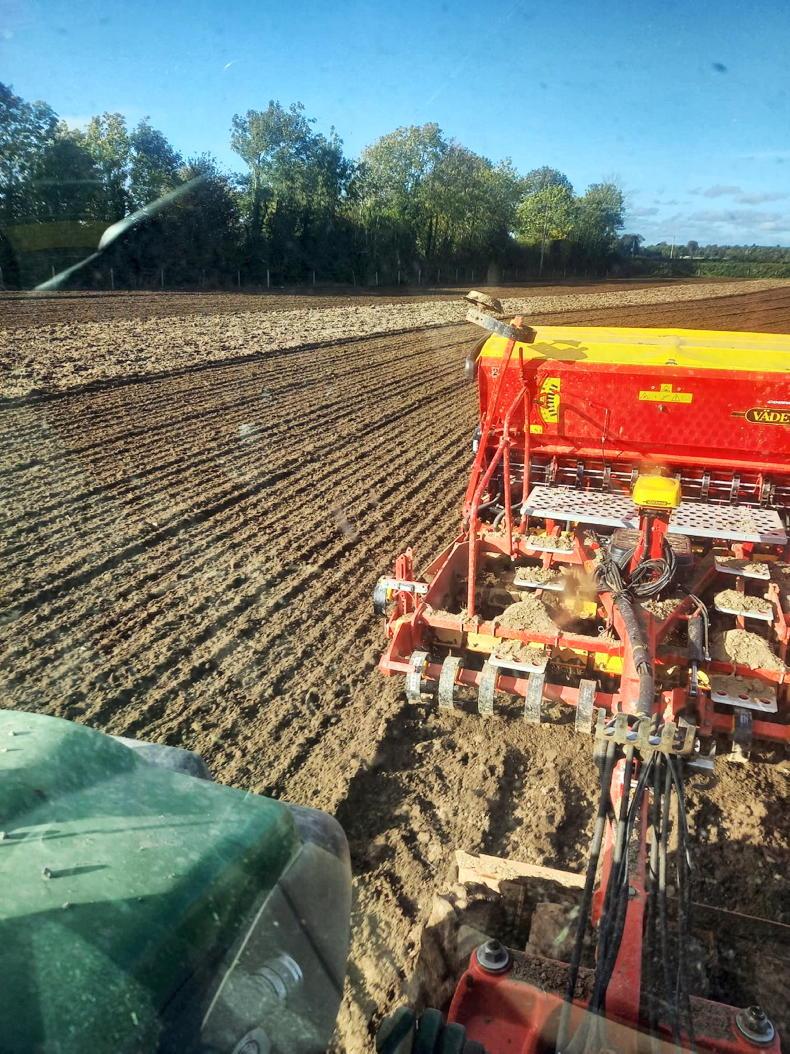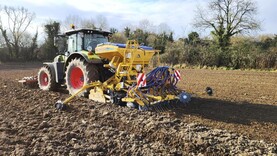Eamonn Cogan finished planting on 18 October. All of the intended area of winter wheat and barley was planted, while an area of oats was also planted.
The 40ac which was destined for winter oats will probably be planted in the spring now.
That ground was disced after straw chopping and is a wetter field, so it will most likely be left until it gets time to dry out in the spring.
All of the winter wheat was rolled, while about half of the winter barley and a field of oats were rolled, but after this, ground conditions were not suitable.
If land dries out enough to travel, the priority will be to get herbicide onto the winter barley.
An aphicide will go on at this time as well. Eamonn might use some different mixtures, including Firebird and Stomp or Tower and Stomp.
Winter wheat
On the winter wheat, Firebird and Crozier or Pacifica might be used, but Eamonn will look at the best value and suitability before deciding.
In the fields, the early-sown winter wheat is at the three-leaf stage, while the late-sown wheat is at the two-leaf stage. There were slugs in some of the wheat, particularly after oilseed rape, and these fields were treated. The first of the winter barley has a second leaf emerging, while the later-sown crop is not up yet.
Oilseed rape is looking super and establishment was really good. The crop is up-to-date with herbicides for broadleaved weeds, grasses and volunteers. Eamonn commented that there is a good canopy, with potential to save on nitrogen, but the challenge will be to keep that canopy there now.
He noted that there are no weak spots in the crop for pigeons to start in, but he will be out with bangers to try and keep the birds at bay.
George has done well with sowing so far, with a large chunk of his crops in the ground, besides what needs to be planted after beet.
The majority of barley and wheat which was planted has received a pre-emergence spray. Some wheat was too close to emergence, so George held back on this crop.
Winter barley received Firebird Met at 1l/ha, while the winter barley received the same product at 0.8l/ha. Oats received DFF at 0.25l/ha.
The rye was the only crop that emerged before 18 October, so George hopes this will help in reducing the risk of barley yellow dwarf virus (BYDV).
The rye remains the only crop which was treated for slugs and that was where it was planted after chopped straw.
George has some grass on the farm that he was able to plough this year and add to the rotation. He noted that it was ploughed, pressed and drilled.
The majority of crops this year were established using minimum-tillage and were planted with a Väderstad drill. This sped up planting significantly.
George always ploughs some fields every year, but finds a mix of the two good for soil health and time management.

George Byrne is nearly finished planting winter crops.
There is some seed winter barley to be planted after beet. The beet would usually be pulled by now, but weather hasn’t allowed this to happen.
The winter barley will go in as long as ground conditions are good. He might try and use a lighter drill planting this crop.
So far, only the headlands of the beet have been pulled, but George commented that it looks to be yielding well and the quality is good.
It is being fed to some cattle in the shed, along with maize silage and rolled barley, which was also grown on the farm.
More cattle are coming in over the coming days and being bought for the winter.
There had been a heavy night of rain in Derry earlier this week when we spoke to Kenny Dunne. Weather over the past few weeks has made sowing difficult and Kenny commented that where he farms seems to have got more rain than other parts in the north of the country.
However, sowing progress has gone well so far, with winter barley all drilled and a lot of winter wheat in the ground. It is the last few crops that are proving more difficult to get planted. There is still some winter wheat to be planted after potatoes, but those potatoes are yet to be harvested.
The fields left to be planted are what Kenny describes as medium soils and if 24 hours came without rain and had a bit of a breeze, he would probably be able to make a start again.
The last of the winter barley went in on 21 October and conditions were very good, with soil drying quickly behind the plough. Seed rates were increased slightly as time went on. At present, 60% of the sown crops has now emerged.
Kenny will aim to get a herbicide onto winter crops once he can travel on land. Crows are the next thing to contend with. Bangers are out on some crops.
The oilseed rape is looking fantastic according to Kenny. Herbicide for broadleaved weeds and volunteer cereals and grasses are all up-to-date. The crop has also received boron and some trace elements.
Kenny sells seed and sales have been good this year. He hasn’t noticed any major change in cropping areas this year. He also hasn’t seen a move away or towards any one crop.
Eamonn Cogan finished planting on 18 October. All of the intended area of winter wheat and barley was planted, while an area of oats was also planted.
The 40ac which was destined for winter oats will probably be planted in the spring now.
That ground was disced after straw chopping and is a wetter field, so it will most likely be left until it gets time to dry out in the spring.
All of the winter wheat was rolled, while about half of the winter barley and a field of oats were rolled, but after this, ground conditions were not suitable.
If land dries out enough to travel, the priority will be to get herbicide onto the winter barley.
An aphicide will go on at this time as well. Eamonn might use some different mixtures, including Firebird and Stomp or Tower and Stomp.
Winter wheat
On the winter wheat, Firebird and Crozier or Pacifica might be used, but Eamonn will look at the best value and suitability before deciding.
In the fields, the early-sown winter wheat is at the three-leaf stage, while the late-sown wheat is at the two-leaf stage. There were slugs in some of the wheat, particularly after oilseed rape, and these fields were treated. The first of the winter barley has a second leaf emerging, while the later-sown crop is not up yet.
Oilseed rape is looking super and establishment was really good. The crop is up-to-date with herbicides for broadleaved weeds, grasses and volunteers. Eamonn commented that there is a good canopy, with potential to save on nitrogen, but the challenge will be to keep that canopy there now.
He noted that there are no weak spots in the crop for pigeons to start in, but he will be out with bangers to try and keep the birds at bay.
George has done well with sowing so far, with a large chunk of his crops in the ground, besides what needs to be planted after beet.
The majority of barley and wheat which was planted has received a pre-emergence spray. Some wheat was too close to emergence, so George held back on this crop.
Winter barley received Firebird Met at 1l/ha, while the winter barley received the same product at 0.8l/ha. Oats received DFF at 0.25l/ha.
The rye was the only crop that emerged before 18 October, so George hopes this will help in reducing the risk of barley yellow dwarf virus (BYDV).
The rye remains the only crop which was treated for slugs and that was where it was planted after chopped straw.
George has some grass on the farm that he was able to plough this year and add to the rotation. He noted that it was ploughed, pressed and drilled.
The majority of crops this year were established using minimum-tillage and were planted with a Väderstad drill. This sped up planting significantly.
George always ploughs some fields every year, but finds a mix of the two good for soil health and time management.

George Byrne is nearly finished planting winter crops.
There is some seed winter barley to be planted after beet. The beet would usually be pulled by now, but weather hasn’t allowed this to happen.
The winter barley will go in as long as ground conditions are good. He might try and use a lighter drill planting this crop.
So far, only the headlands of the beet have been pulled, but George commented that it looks to be yielding well and the quality is good.
It is being fed to some cattle in the shed, along with maize silage and rolled barley, which was also grown on the farm.
More cattle are coming in over the coming days and being bought for the winter.
There had been a heavy night of rain in Derry earlier this week when we spoke to Kenny Dunne. Weather over the past few weeks has made sowing difficult and Kenny commented that where he farms seems to have got more rain than other parts in the north of the country.
However, sowing progress has gone well so far, with winter barley all drilled and a lot of winter wheat in the ground. It is the last few crops that are proving more difficult to get planted. There is still some winter wheat to be planted after potatoes, but those potatoes are yet to be harvested.
The fields left to be planted are what Kenny describes as medium soils and if 24 hours came without rain and had a bit of a breeze, he would probably be able to make a start again.
The last of the winter barley went in on 21 October and conditions were very good, with soil drying quickly behind the plough. Seed rates were increased slightly as time went on. At present, 60% of the sown crops has now emerged.
Kenny will aim to get a herbicide onto winter crops once he can travel on land. Crows are the next thing to contend with. Bangers are out on some crops.
The oilseed rape is looking fantastic according to Kenny. Herbicide for broadleaved weeds and volunteer cereals and grasses are all up-to-date. The crop has also received boron and some trace elements.
Kenny sells seed and sales have been good this year. He hasn’t noticed any major change in cropping areas this year. He also hasn’t seen a move away or towards any one crop.







 This is a subscriber-only article
This is a subscriber-only article











SHARING OPTIONS: